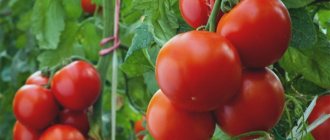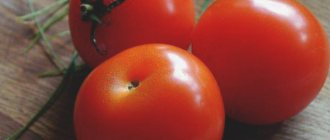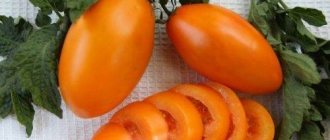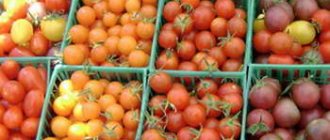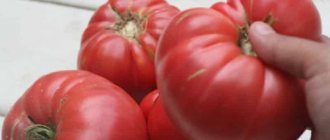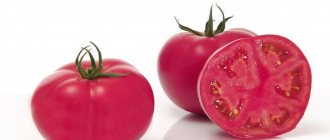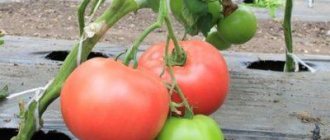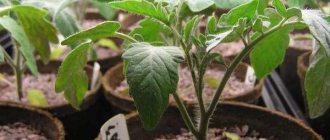I. Hybrids
The characteristics of tomato fruits are impressive:
- rich red color;
- the berry is dense;
- the skin is strong;
- round shape with drop-shaped descent;
- the fruit is slightly depressed at the stalk;
- weight up to 120 g;
- sweet taste with tomato sourness;
- pleasant bright aroma.
Ripe Donskoy fruits have a dense consistency. Delicious salted and marinated. Stuffed tomato halves will decorate any table.
Tomato Donskoy F1 requires minimal care. The requirements are simple and common for hybrids:
- sow seedlings after March 20;
- illuminate the seedlings with an agricultural lamp for up to 18 hours;
- picking into separate containers in the phase of 2 true leaves;
- be sure to feed with mineral complexes for seedlings 2 times;
- harden, ventilate;
- do not over-moisten;
- place on beds in May (under film, in a greenhouse);
- feed with phosphorus-potassium fertilizers according to the manufacturer’s scheme;
- Garter recommended.
The plant is prone to being overloaded with tomatoes. To prevent fruit rotting, drip irrigation of the beds should be arranged. This will reduce water consumption and prevent moisture from getting on the leaves. It is recommended to combine watering with fertilizing. The application of mineral complexes should be stopped 20 days before the planned harvest.
Donskoy's first harvest is larger than subsequent ones. Gardeners should monitor the weather forecast: before the August cold snap, the entire crop must be harvested. This way the hybrid will be saved from late blight.
Tomatoes require minimal care. To ensure a crop harvest, seedlings need to be sown in the third ten days of March. Before sowing, the seeds are hardened and treated in a solution of potassium permanganate. With the emergence of seedlings, the room is additionally illuminated with an electric lamp for up to 18 hours a day.
In the phase of formation of 2 true leaves, seedlings are picked. Plants are fed with complex fertilizers. Planting in a garden bed or greenhouse is carried out in May.
Plants are fed with phosphorus and potassium fertilizers according to the manufacturer’s scheme. Abundant fruiting overloads the bush with tomatoes, so in the process of forming the bushes an additional garter is used.
To prevent fruit rotting, drip irrigation of the soil is recommended. This reduces water consumption and prevents moisture from getting on the leaves. 20 days before the planned harvest of fruits, stop applying mineral fertilizers.
The hybrid is not resistant to late blight, but tolerates cladosporiosis and does not suffer from TMV. The culture is popular among vegetable growers. With minimal labor input, growing tomatoes provides the opportunity to get an early harvest.
Hybrid tomatoes are virtually guaranteed to be resistant to diseases and bad weather conditions, which is something that non-hybrid varieties suffer from. Greenhouses and greenhouses are valued for storing heat, but in them tomatoes can suffer from too high temperatures and sudden temperature changes. In recent years, world selection has been aimed at producing “heat-resistant” hybrids with a reliable guarantee of ovary production.
Hybrids are especially helpful in a greenhouse or a small garden plot where there are no real opportunities for crop rotation and diseases are prevalent. Selection successes demonstrate confident resistance to various types of infections - viral (especially the most dangerous tobacco mosaic virus), fungal, bacterial. In addition, the hybrids have uniform fruits and consistently high yields.
Tomato Incas F1
One of the best hybrids for canning whole fruits without skin. Popular early high-yielding bush hybrid. The plant is medium-sized, compact.
Tomato from the Dutch company Numens, zoned in Russia; entered into the state register in 2000. Mid-early hybrid (105 days) of meter-high vegetables, determinate. Very high resistance to fungal diseases has been recorded. The fruits are 80-100 g, dense, bright red, pepper-shaped, fleshy, uniform, tolerate sunburn well, are very easy to ripen, transported over long distances without loss of quality.
Tomato Torquay F1
Dutch hybrid from Bejo Zaden; in the Russian register since 2007. Mid-season tomato (119-123 days from germination to ripening), bush type - determinate, maximum height 100 cm. Forms abundant multiple clusters with fruits weighing 60-140 g. Dense tomatoes withstand long-term transportation, excellent in pickling and pickling matters.
Tomato Mariana F1
The tomato was created in the French branch of the Japanese company Sakata (the image of the woman Mariana is a symbol of the French Republic). The breeders of this agricultural company are often suspected of producing GMOs, but so far without real evidence. Mariana is a mid-early determinate hybrid. The fruits are similar in shape to Incas - also elongated-oval, perfectly smooth, super dense.
Tomato Bagheera F1
Hybrid from the leading French seed company Cloz. Included in the Russian seed register in 2007.
Early high-yielding hybrids are a real boon for the garden. They are cold-resistant, do not need pinching or tying up, and practically do not get sick. The ripening period is marked as medium-early; determinate bush. The fruit is round, flattened on top, ribbed, weight ranges from 80-220 g. The hybrid is resistant to soil drought and nematode, more suitable for regions located in the south. Does not suffer from fusarium and verticillium wilt.
Tomato F1 Semko 2005
The tomato is suitable for open ground and under film shelters (greenhouses). Determinate, medium-sized, compact. Resistant to soil salinity, drought, high temperatures, grows well in open ground in both southern and northern regions. Vegetables practically do not suffer from viral and fungal diseases, even late blight.
Tomato F1 Semko 2010
Included in the state register in 2010. Ultra-early ripening determinate hybrid - 85-88 days pass from the sprouting of green vegetables to the coloring of fruits. The first brush is formed immediately after the sixth leaf grows. The fruits are incredibly dense for such an early tomato, and are by no means small - 130 g. The shape is round hearts with a beautiful pointed tip.
In open ground, we usually plant thickly - 5-6 bushes per square. The best harvest from such an area is at least a bucket. The hybrid is highly resistant to bacteria, fungi and viruses. Does not crack and does not suffer from blossom end rot. Successfully withstands high temperatures and dry soil.
The newest indeterminate hybrid (on the register since 2015) - tested by us, everything is fine - created taking into account all possible greenhouse disasters. Firstly, it sets well even in the heat, as well as during temperature changes. Secondly, it is tolerant of problematic soil substrates. Thirdly, it shows high resistance to viral, fungal and bacterial infections.
The yield of vegetables varies between 20-30 kg/1 square meter. Mid-early hybrid (100 days from green shoots). The clusters begin to form after 7-9 leaves, each bears 5-6 tomatoes in the shape of rounded hearts, smooth, beautiful, attractive orange color. The weight of the “heart” is 160-190 g. The pulp contains a high percentage of dry matter, sugars, and carotenoids.
Bushes of unlimited growth, with dense foliage. Mandatory shaping is required, including a garter. Hybrid of medium early or medium ripening period (112-118 days). Clusters of 6-8 tomatoes weighing 130-150 g. The fruits are plum-shaped, slightly tapering downwards. They are deep red in color, thick-skinned, with a high percentage of dry matter.
Tomato Empire F1
Indeterminate hybrid of a new generation, in the state register since 2011. Medium-early (100 days - 2 days - from germination). The plant is tall, much taller than other types of tomatoes. Therefore, the tomato requires gartering and pinching. Tomatoes are oval-shaped with a spout, weight ranges from 80 to 140 g. On average, 9 kg are obtained per bush. The color of the fruit is red-orange. The skin and pulp are dense. Can be stored for 6-7 weeks. In greenhouses people do not suffer from viral and fungal infections.
On the register since 2015. The bushes are semi-determinate, beautiful, a meter and a half high. Suitable for any soil - open or closed. Plants require pinching. Multiple clusters bear up to 30 fruits with a sweet taste and a perfect “strawberry” shape. The weight is typical for classic cherry tomatoes - 25 g. Thanks to the strong skin, the fruits can be stored for a long time. Early hybrid: ripe fruits appear 91-93 days after the sprouts emerge. The plant is resistant to Fusarium wilt.
READ MORE: Mantet apple tree variety description photo reviews from gardeners
Tomato F1 Kaspar
The bush is short, usually up to the first cluster, 60 cm. The fruits of the plants are cylindrical with a spout, the length varies around 11 cm, and the weight is 95-115 g. They are very dense, without juice. It is convenient to pickle them assorted with cucumbers of a similar size.
The average ripening period is 115 days. The hybrid is intended for open ground, or is planted under low shelters; We plant three to four vegetable bushes per square.
Tomato Aunt Valya F1
Valya f1 tomatoes are early-ripening, tall hybrids with average yield. The bushes easily and quickly reach a height of 200 cm. In the register since 2015. Productivity is within 20 kg per square meter. On average, one bush produces 7 kg of tasty and beautiful tomatoes. Tomatoes ripen simultaneously, reaching 200-250 g in weight.
The fruits have a regular round, slightly oblong shape. The scope of use of tomatoes is very wide. Salads are prepared from the first fruits. As the volume of the harvest increases, the fruits are used for winter harvesting, as well as juices, ketchups, pastes, sauces and lecho. Tomatoes retain commercial quality for a long time and tolerate transportation and long-term storage well.
Description and characteristics of the variety
Tomato Donald is a determinate, low-growing hybrid. The bushes grow compact and strong, the height of the shoots does not exceed 45 cm. The cluster hybrid produces fruitful clusters with 7-10 tomatoes
Ripening dates are early - 80-95 days from germination.
Description of tomatoes:
- neat round shape;
- average weight within 40-60 g;
- thick skin;
- moderately juicy pulp;
- The taste harmoniously combines sweetness and sourness.
Tomatoes are used universally - for fresh consumption and for various winter preparations.
Characteristics
The variety was included in the state register of the Russian Federation in 2007, recommended for cultivation in greenhouses and open ground conditions. It is distinguished by its early ripening period; from the moment of the first shoots to the appearance of ripe fruits, only 90-95 days pass. The bushes are indeterminate, approximately 120-130 centimeters in height.
The fruits are round, slightly elongated, approximately 10 cm in diameter, weighing on average 180-200 grams. When ripe, tomatoes turn bright red. The taste is excellent. The skin is dense, smooth, the flesh is tender and sour and has 4-6 seed chambers. Primadonna tomatoes are suitable for summer salads, making juice, ketchup, as well as an ingredient for winter assorted dishes. Small tomatoes can be canned whole.
Due to the fact that the variety does not have a predisposition to cracking, the fruits remain intact even when transported over long distances. Productivity indicators are high; under good conditions and the necessary care, up to 17 kg of delicious tomatoes can be harvested from one square meter. And thanks to the fact that the breeders took care of its strong immunity when creating the variety, it is resistant to many diseases, such as fusarium, alternaria, verticillium and tomato mosaic virus. As a preventive measure against pests, plants are treated with special means.
Growing seedlings
Seed material is soaked in a manganese solution, this contributes to even greater plant resistance to disease. Experienced gardeners recommend germinating seeds in a damp cotton cloth before planting. The soil for planting must be moisture-permeable and loose. Before sowing, containers should be washed well with laundry soap.
To ensure that the root system has enough space, when 1-2 leaves appear, the plants are transplanted into separate containers; this procedure is called picking. Caring for seedlings is simple; it consists of watering, loosening the soil and adding minerals. Also, the conditions of maintenance are important for the plant.
The seedlings are planted in the beds when they have reached two months of age. At this point, each plant should have at least seven true leaves.
The Donskoy F1 tomato inspires those gardeners who have not yet planted a hybrid. After a long winter, I want to quickly enjoy my own berries. A tomato will easily satisfy this desire.
What it is
Agrobiologists offer a description of the hybrid:
- early ripening period (90 days from loops to the first tomato);
- determinant;
- a compact bush grows up to 0.6 m;
- medium sized leaf, bright green;
- forms ovaries under unfavorable conditions (heat, spring coolness);
- friendly return of the harvest;
- tomatoes are simply removed from the mother plant;
- easy to transport to the place where the crop is stored;
- excellent keeping quality;
- tomatoes are ripened in a dark, warm room (in a closet, in the attic).
Tomatoes do not fall off and do not rot on the bush. They ripen in two waves. To speed up ripening, it is recommended to remove brown tomatoes and ripen them at home.
Hybrid Primadonna F1 was included in the register in 2007. The author of the cultivar is Yuri Ivanovich Panchev, an employee of the research center for selection of seed production and agricultural technology of Transnistria.
Panchev is a famous breeder. He developed and patented 25 varieties of tomatoes, including the mega-popular Sanka and Lyana.
In addition to the original designer seeds, sold in branded bags marked NICSSA, you can find Primadonna on sale, sold under the following trademarks:
- tomato Primadonna F1 Biotechnika;
- tomato Primadonna Sedek;
- tomato Diva Aelita;
- tomato Primadonna Siberian Garden.
Primadonna is an early determinate hybrid for film greenhouses and open ground with red fruits of a specific shape. The variety's tomatoes are round, with a smooth surface, almost without ribs. The nose protrudes from below the fetus.
Tomatoes ripen 90-95 days after germination.
Fruits weighing about 180 g, for salad purposes, with four to six nests, taste and commercial quality are high.
The height of the bush is up to 130 cm. Few leaves are formed. The tomatoes are well lit by the sun and ventilated. Due to the small number of leaf plates, cleaning is carried out without much difficulty.
The Don Juan tomato is a low-growing determinate plant that stops growing when it reaches 70 cm. The variety is early ripening - the first harvest appears 90-100 days after seed germination. The fruits are collected in clusters of 6-7 pieces. They are oval, plum-shaped, medium-sized, 80-100 grams. The skin is colored red, mottled with yellow stripes, which begin to appear even when the fruit is green.
Pickled fruits turn out especially beautiful: they do not lose color and the skin does not crack.
Description of tomato Primadonna
The hybrid Primadonna F1 was bred by Russian breeders and included in the State Register in 2007. With its taste and practical qualities, it has conquered even the most demanding gardeners. The variety was bred for gardening, but its good yield has made it popular in small farms.
Primadonna F1 belongs to determinate varieties; on average, the height of the bush does not exceed 1.2 meters. The plant grows and bears fruit equally well in a greenhouse and in open ground. The early ripening of the variety allows one to obtain a high yield even in conditions of short daylight hours. The tomato is recommended for cultivation in all regions.
Sparse foliage allows fruits to receive more sunlight
The plant requires pinching to form a bush; growth is limited to the last flower cluster. The thick stem has not very dense foliage, which allows the fruits to receive more light. The root system develops horizontally, without going deep into the soil.
The tomato is an early-ripening variety; the first harvest ripens 92–95 days after germination. The average yield of the variety is up to 7 kg per bush and up to 18 kg per 1 sq. m. Proper care and adherence to planting dates allow you to get two harvests over the summer. However, we must take into account that at the end of the season the fruits will begin to shrink.
Advantages and disadvantages
The Donskoy tomato is intended for growing in open ground conditions, in greenhouses without heating.
Agrobiological specialists describe the hybrid as an early-ripening crop that does not tolerate heavy watering. The growing season from the appearance of loops to the collection of the first fruits is 90 days. The determinate bush reaches a height of 60 cm. The bright green leaves are medium in size.
Main characteristics of the first generation hybrid:
- ovaries are formed even under unfavorable conditions (cold, hot);
- uniform ripening of the crop;
- The fruits are easily removed from the branch and are resistant to transportation.
The bushes produce tomatoes of a rich red color with a bright aroma, sweet and sour taste, weighing up to 120 g. The tomatoes are round in shape with a drop-shaped slope and have a dense skin.
In cooking, tomatoes are used for canning and pickling.
This hybrid is really very convenient for growing by amateur gardeners.
- Firstly, it is very unpretentious and quite easy to grow. In particular, simple automatic watering will allow you to successfully grow this variety, coming to your site only on Saturday and Sunday.
- Secondly, it, like many hybrids, is resistant to brown leaf spot (cladosporiosis).
- Thirdly, its plants are not infected with tobacco mosaic virus (TMV).
Pros:
- resistance to late blight;
- early ripeness;
- does not require capital greenhouses;
- excellent taste, which is ensured by the optimal combination of organic acids and sugar;
- good tying in cold rainy weather;
- genetic resistance to a complex of diseases of open ground tomatoes;
- transportable;
- productive;
- high adaptive abilities.
READ MORE: How to arrange a terrace with your own hands, choosing decor and plants
Minuses:
- tall bushes - requires tying;
- you have to make stepsons, however, few side branches are formed;
Pros:
- early ripeness;
- productivity;
- unpretentiousness.
Cons: Pros:
- great taste;
- interesting appearance;
- unpretentiousness;
- high productivity;
- resistance to diseases.
Minuses:
Features, advantages and disadvantages of Primadonna F1 tomatoes
A distinctive feature of the Primadonna F1 hybrid is the formation of a brush after 1–2 leaves, an average of 7 brushes in total over the entire life cycle. 5–7 fruits ripen on one cluster. Another feature of the variety is its resistance to cracking obtained through selection. Thanks to this quality, fresh tomatoes are well stored and do not spoil during transportation.
Table: varietal characteristics of Diva F1
- Northern;
- Northwestern;
- Central Chernozem;
- Central;
- Volgo-Vyatsky;
- North Caucasian;
- Middle Volga
- open ground;
- greenhouse
- tobacco mosaic virus;
- Alternaria blight;
- verticillium;
- late blight;
- cladosporiosis
- tobacco mosaic virus;
- Alternaria blight;
- crown and root rot
- fusarium;
- tobacco mosaic virus
- verticillium;
- fusarium;
- nematode
Advantages of the hybrid Primadonna F1 compared to similar varieties:
- good yield even on poor soils;
- suitability for cultivation in any region;
- the ability to grow in open beds and greenhouses;
- excellent immunity to most tomato diseases;
- ease of care.
Tomatoes demonstrate excellent fruit set in all weather conditions.
Donskoy - variety of tomato plant
Donskoy successfully settled in private gardens. Gardeners are attracted by his data:
- does not require complex care;
- resistant to cladosporiosis;
- does not suffer from TMV.
With a minimum of labor, it is possible to obtain early, tasty products. The Donskoy hybrid is ideal for people who visit their plots only on weekends. Simple automation of water supply and ventilation of the greenhouse will solve the problem of daily presence. The unpretentious plant will do the rest.
What it is
Reviews
Reviews of the Donskoy F1 Vkusny tomato give a positive assessment. Everyone was pleased with the simultaneous formation of ovaries and good yields. Gardeners gave the hybrid a unanimous “five” for its ripening period. The taste and consistency of the tomato were rated “good.” The skin received a “bad” rating. The skin was considered too rough. At the same time, they recognized that it is precisely this that makes the Donskoy fruits transportable.
Among the variety of nightshade crops, the Donskoy F1 tomato, reviews of which are associated with excellent taste, is distinguished by the simplicity of agricultural technology.
Reviews from gardeners indicate the positive qualities of the fruits and simple agrotechnical conditions for growing the crop.
“I grow the Donskoy hybrid at my summer cottage for several seasons in a row. This variety is convenient because ovaries form on it at the same time, which ensures wave ripening of tomatoes. This provides the opportunity to harvest a high yield once a week.”
“I often experiment with growing different varieties of tomatoes. Last year, Donskoy fruited well on the plot. The strangely shaped fruits ripen at the same time, they differ in taste and aroma. The only drawback of tomatoes is their thick skin, but during transportation it allows you to keep the fruits safe and sound. I’m happy with the tomatoes.”
“I cultivate the Donskoy tomato in my garden. To ensure productivity and increase the resistance of bushes to the effects of late blight, I grow seedlings myself. At the same time, I adhere to the recommendations of experienced vegetable growers related to agricultural cultivation techniques. Special treatment of seeds with a solution of potassium permanganate ensures the appearance of friendly shoots and creates additional resistance to late blight. Tomatoes do not require special care. Simple rules allow you to get a high yield of fragrant fruits from each bush.”
Tomato Donskoy F1, as its name suggests, is a hybrid variety. Such varieties are created by breeders in order to take their best qualities from the parent varieties and, if possible, get rid of the shortcomings. As a rule, hybrid types are characterized by higher disease resistance, increased vitality, and better productivity. As can be seen from the reviews of gardeners, Donskoy F1 has exactly these properties.
Gardeners especially like the yield of the variety and the friendly formation of ovaries. Survey respondents especially note the early ripening of its fruits. The consistency of the fruit and its taste are considered “good”. Only the skin, which many consider too rough, earned negative reviews; on the other hand, it is precisely this feature of the hybrid that makes its transportation and storage efficient and easy.
Tomatoes Diva on video
If you grew Primadonna tomatoes, please write what the yield and taste of the fruit were in your climatic conditions. How do you rate the disease resistance of this tomato? Briefly describe the advantages and disadvantages of this tomato in your opinion. If possible, attach a photo of the entire bush or individual fruits you grew to your comment. Thank you!
Your reviews of the Primadonna tomato and additions to the description will help many gardeners evaluate this hybrid more objectively and decide whether it is worth planting or not.
Features of cultivation and storage
Early maturing hybrids of limited growth stop developing after the formation of 4-5 clusters. Unlike super-determinate cultivars, which do not need to be pinched at all (Lyana, Novinka Pridnestrovya), the plant has to fight the stalks, otherwise the bush will be overloaded with berries and ripening will be delayed. At the same time, the variety loses its main advantage - early production of ripe fruits.
The first flower cluster is tied after 5-7 leaves, the next ones every two leaves. The bushes have to be propped up with pegs so they don’t fall.
Tomatoes are grown only through seedlings. Planting of plants in open ground or a greenhouse is carried out when the soil warms up to at least 15 degrees and the danger of cold snaps disappears to temperatures below 10 degrees. Seedlings are placed in the garden according to a 50 by 40 cm pattern.
For good growth, plants will need:
- timely watering,
- regular feeding,
- loosening the soil
- weeding.
Despite their salad purpose, the fruits are well stored, as they have dense pulp and durable skin. They not only last a long time, but are also easily transported, which makes this hybrid suitable for commercial production.
The fruits of this variety have impressive characteristics. They are strong in consistency and have a rich red color. They are characterized by a pronounced pleasant aroma and excellent sweet and sour taste. These tomatoes are not too large in size, their weight can reach 120 grams.
The shape of the fruit is round, with a drop-shaped descent, with a small depression in the area of the stalk. The skin is dense and durable. The fruits are used primarily for making canned food and pickles.
You can grow tomatoes both in protected greenhouses and in the garden. They need tying so that the branches do not bend to the ground under their own weight. In addition, the bushes are pruned, removing excess shoots.
The harvested crop is well stored due to its thick skin.
Traditionally grown through seedlings.
The bushes are transplanted to a permanent location at the age of 45-50 days.
Basic moments:
- formation in 3 shoots;
- tying to a support;
- mulching with a layer of 10 cm.
Planting and care
Seeds are sown in the 1st-2nd decade of March.
Growing seedlings
Until germination, the boxes are kept under film.
How to care for seedlings:
- irrigation through a spray bottle;
- watering with Kemira-Lux;
- lighting with phytolamps;
- picking with 2 true leaves.
Watering
Water moderately 2-3 times a week, the norm for 1 bush is 5-6 liters. Water is poured at the root. It is better to use settled and warm water.
At the ripening stage, watering is reduced in frequency and volume.
Hybrid feeding
They begin to carry out this already at the seedling stage. Use liquid 1:10 diluted chicken manure or mullein. Add 4 g of phosphorus and 1 g of potassium preparations per 1 liter of water.
Feeding required:
- when flowering;
- during the formation of the ovary;
- at the maturation stage.
Mid-early / Low-growing
User rating: 5/5
Early maturing / Low growing
User rating: 5/5
Early maturing / Low growing
Seeds are planted for seedlings in March if they plan to transfer them to a greenhouse, and a little later, depending on the climate, if they will be grown in open ground.
The Don Juan tomato is very sensitive to cold, so it is not transferred to the beds under the sky until the end of May, when the risk of frost has passed.
The seeds are buried 1 or 2 cm, carefully watered with a spoon or from a spray bottle and cover the containers with film. Before germination, the temperature is kept at 23-25, and then reduced to 18 for a week. This measure prevents the bushes from stretching to the detriment of development. Then the temperature is raised again to 23.
When the seedlings have 2 true leaves, they are planted in separate large pots so that the root system develops better.
Before transplanting to a permanent place, the seedlings should be hardened off by taking the boxes with them outside during the day. The period of exposure to air is increased every day, and at night the seedlings are kept indoors at a temperature of 10-15. After a week, the seedlings are ready.
Care, in addition to tying and pinching, includes watering twice a week, weeding and fertilizing two to three times a season. You need to feed with mineral fertilizers, as well as organic matter - bird droppings with water, humus, wood ash.
Early maturing / Low growing
User rating: 5/5
Mid-early / Low-growing
User rating: 4.9/5
Ultra-early / Low-growing
Seeds are sown in nutritious, loose soil, stored in the fall or purchased in a store. Sowing time is 45-50 days before the expected planting of seedlings in open ground. In the middle zone, seedlings of early ripening hybrids are sown in the third decade of March, and in mid-May the seedlings are planted under film. They can be transferred to open ground in early June. Good seedlings have 5-7 true leaves.
Before planting, Primadonna tomato seeds should be soaked for 20-30 minutes in a pink solution of potassium permanganate, then rinsed in running water. Experienced gardeners, after disinfection, also germinate the seeds by wrapping them in damp cotton cloth. The procedure speeds up the emergence of seedlings and allows you to check the quality of the seed.
After disinfection, the seeds can be sown immediately without germination. In this case, the seedlings will appear 3-4 days later.
READ MORE: Types of aloe with photos and names description of all varieties
Sowing is carried out in wide boxes 10-15 cm deep. Seedlings dive in the phase of 1-2 leaves.
Early maturing / Medium growing
User rating: 4/5
Early maturing / Medium growing
User rating: 5/5
Late-maturing / Medium-growing
The Adonis F1 tomato variety is grown exclusively in greenhouse conditions. The characteristics of the variety do not require planting plants in open ground. In practice, growing tomatoes of this variety includes two successive stages: growing seeds and planting in greenhouse soil.
First of all, it is necessary to prepare the soil approximately 14 days before sowing. Tomatoes of the Adonis variety prefer loose soil with a good drainage layer. Most often, loam and chernozem meet these requirements. The soil is pre-moistened, leaving time for drying and loosening. The next step is planting the seeds in the prepared soil:
- Furrows are made in the soil 1.5-2.0 cm deep.
- The seeds are lowered to the bottom of the channel, leaving 2-2.5 cm of free space between them.
- Carefully fill the furrows with soil.
- The area with the planted seeds is covered with plastic film.
The next stage - planting seedlings in greenhouse soil - is possible after germination of at least half of the seeds.
The optimal time for planting seedlings is 55-65 days after planting the seeds. During this period, the seedlings acquire sufficient sprout thickness to grow in greenhouse soil. Prepare the soil based on the tomatoes’ preferences for good drainage. A sufficiently sized area is prepared for planting.
Next, begin planting seedlings:
- The depth of the hole should be ½ the length of the tomato stem.
- Sufficient moistening of the prepared hole is necessary.
- Each sprout is transferred carefully, trying not to damage the vulnerable root system.
- The roots are sprinkled with soil and the soil is lightly compacted.
- The distance between adjacent bushes should be at least 35 cm. It is also necessary to maintain row spacing.
Optimal transplantation of young bushes will ensure in the subsequent period high yields, plant resistance to pests and good taste of the fruit.
During the process of growth and fruiting, Adonis tomatoes require careful care, which includes:
- Watering.
- Feeding.
- Loosening the soil.
- Garter of stems.
The last two points do not require any special skills or practical experience. Loosening should be done carefully, trying not to damage the root system. The stems are tied as the bush grows to ensure maximum access to ripe fruits and good air circulation between the densely spaced branches.
Watering requirements
This variety requires medium-intensity watering, but always with warm, settled water. The average interval between waterings is three days; during hot periods, the interval can be reduced to two days. Both insufficient watering and excess moisture are unsafe for the plant:
- Fruits with cracks and grooves on the surface may indicate irrational watering or lack of water in the soil.
- Excessive foliage growth, small fruits and a decrease in the rate of ripening of tomatoes indicate too much watering.
Despite the resistance of Adonis tomatoes to many pests, excess moisture in the soil and surrounding air can become a risk for the development of fungal colonies on the bushes. To prevent fungus, you need to carefully regulate the humidity level and the need for frequent watering of the soil.
The greenhouse growing environment allows for careful control of soil fertilization. During the process of growth and ripening of fruits, the bushes need to be fed 4 times; with a modified scheme (commercial greenhouses with an extended growing interval), the amount may increase. Fertilizers are applied to the soil according to the scheme, and preference is given to the following compositions:
- Ammophos.
- Wood ash as a source of potassium.
- Superphosphate.
- Sodium humate in two consistencies.
Optimal care also includes monitoring temperature and daylight hours. Careful control allows the high yield and quality characteristics of the fruit to be used for commercial purposes.
Growing principles
- In order to obtain a high yield and fruits of excellent quality, the seeds are first germinated into seedlings, which are then planted in the ground.
- To count on a high harvest, seeds should be sown for seedlings after March 20. Seeds for germination begin to be prepared in advance. First, dissolve potassium permanganate in water: up to one gram of crystals of the substance per glass of water. Tomato seeds are soaked in this solution for twenty minutes.
- To germinate seeds, prepare containers by filling them with nutritious soil, which is then moistened and compacted. When seedlings appear, the seedlings should be illuminated with an agricultural lamp for a long time, up to 18 hours every day.
- As the seedlings grow, they require care in compliance with certain rules. Containers are watered at intervals of one or two weeks, depending on how much moisture the top layer of soil retains. For the proper development of seedling shoots, it is necessary to maintain a special temperature regime. In order for the stems to form strong, the seedlings must be periodically hardened off and ventilated.
- While growing seedlings, they need to be fed at least twice. Special mineral complexes for seedlings are suitable for this.
- After the second true leaf appears, the seedlings are picked and transplanted into a larger container. This is necessary so that the root system becomes strong.
- Glasses or containers of 500 ml are quite suitable for picking. It is advisable to complete this procedure by feeding the seedlings with complex fertilizers.
- Seedlings are planted in the soil in May. This can be done both in open ground and in a greenhouse. If you plant a tomato in a greenhouse, it must be prepared. They begin to do this in the fall, when the harvest of the past season has already been harvested. The greenhouse is disinfected to remove pathogenic fungi and pests from it. If it is built of wooden structures, it is fumigated with sulfur. If the greenhouse is built on a metal frame, the inside can be sprayed with a bleach solution. The soil is also disinfected using Bordeaux mixture.
- Before planting tomatoes in the ground, containers with seedlings are spilled with water; if long roots extend beyond the glass, they are shortened. Seedlings are buried in the holes to the bottom leaf; if the plant is very elongated, it is planted at an angle and the stem is partially covered with soil. After planting, the soil near the stem of the seedlings is compacted, the plants are well treated with a solution of Bordeaux mixture (100 grams are dissolved in 10 liters of water). After this, the plants are tied to the supports.
- After planting tomatoes in the ground, they should be regularly fed with phosphorus-potassium fertilizers according to their manufacturer's instructions. The Donskoy F1 variety is characterized by very abundant fruiting, which can overload the plant stems with fruits. Because of this, agronomists recommend the use of garter bushes.
Since Donskoy F1 tomatoes do not like heavy watering, in order to protect the fruits from rotting, it is advisable to use the option of drip irrigation of the beds. This will prevent moisture from getting on the leaves. You should continue to feed the plants with mineral complexes regularly. You can stop fertilizing 20 days before the planned harvest.
Keep in mind that the first harvest is always more abundant than subsequent harvests. In any case, all fruits should be removed before the cold snap begins in August to save the plants from late blight.
tomato Jempakt - description and characteristics of the variety

